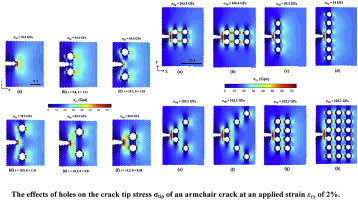Our official English website, www.x-mol.net, welcomes your
feedback! (Note: you will need to create a separate account there.)
Atomistic simulations of nanoscale crack-vacancy interaction in graphene
Carbon ( IF 10.5 ) Pub Date : 2017-12-01 , DOI: 10.1016/j.carbon.2017.09.015 M.A.N. Dewapriya , S.A. Meguid
Carbon ( IF 10.5 ) Pub Date : 2017-12-01 , DOI: 10.1016/j.carbon.2017.09.015 M.A.N. Dewapriya , S.A. Meguid

|
Abstract Linear elastic fracture mechanics establishes the conditions necessary for crack arrest by the introduction of a hole in its path. However, it is unclear how nanoscale crack-vacancy interaction manifests itself at the atomistic level. In this study, we employ molecular dynamics simulations to investigate the nanoscale crack-vacancy interaction in graphene by performing nanoscale uniaxial tensile test. Three aspects of the study are considered: (i) to create design envelopes to ascertain crack tip shielding zones (reduction in the stress field) and crack tip amplification zones (increase in the stress field) as a result of the presence of atomistic vacancies ahead of the crack tip, (ii) to examine the ability of the current system to arrest propagating cracks by the strategic placement of the nanoscale vacancies, and (iii) to investigate the crack healing phenomenon. Our results reveal that the nanoscale central crack can be arrested by the strategic positioning of symmetric nanoscale holes. Moreover, the presence of holes in close proximity to the crack tip leads to multiple stage crack growth involving both self-similar and crack branching. The study further reveals that the initially propagating cracks completely healed even though the applied tensile strain is not fully diminished.
中文翻译:

石墨烯中纳米级裂纹-空位相互作用的原子模拟
摘要 线弹性断裂力学通过在其路径中引入一个孔来建立止裂所需的条件。然而,目前尚不清楚纳米级裂纹-空位相互作用如何在原子水平上表现出来。在这项研究中,我们采用分子动力学模拟通过执行纳米级单轴拉伸试验来研究石墨烯中纳米级裂纹-空位相互作用。研究的三个方面被考虑:(i)创建设计包络以确定裂纹尖端屏蔽区(应力场减少)和裂纹尖端放大区(应力场增加)由于前方存在原子空位裂纹尖端,(ii)检查当前系统通过纳米级空位的战略位置阻止传播裂纹的能力,(iii) 研究裂纹愈合现象。我们的结果表明,纳米级中心裂纹可以通过对称纳米级孔的战略定位来阻止。此外,靠近裂纹尖端的孔的存在导致涉及自相似和裂纹分支的多阶段裂纹扩展。研究进一步表明,即使施加的拉伸应变没有完全减小,最初传播的裂纹也完全愈合。
更新日期:2017-12-01
中文翻译:

石墨烯中纳米级裂纹-空位相互作用的原子模拟
摘要 线弹性断裂力学通过在其路径中引入一个孔来建立止裂所需的条件。然而,目前尚不清楚纳米级裂纹-空位相互作用如何在原子水平上表现出来。在这项研究中,我们采用分子动力学模拟通过执行纳米级单轴拉伸试验来研究石墨烯中纳米级裂纹-空位相互作用。研究的三个方面被考虑:(i)创建设计包络以确定裂纹尖端屏蔽区(应力场减少)和裂纹尖端放大区(应力场增加)由于前方存在原子空位裂纹尖端,(ii)检查当前系统通过纳米级空位的战略位置阻止传播裂纹的能力,(iii) 研究裂纹愈合现象。我们的结果表明,纳米级中心裂纹可以通过对称纳米级孔的战略定位来阻止。此外,靠近裂纹尖端的孔的存在导致涉及自相似和裂纹分支的多阶段裂纹扩展。研究进一步表明,即使施加的拉伸应变没有完全减小,最初传播的裂纹也完全愈合。











































 京公网安备 11010802027423号
京公网安备 11010802027423号